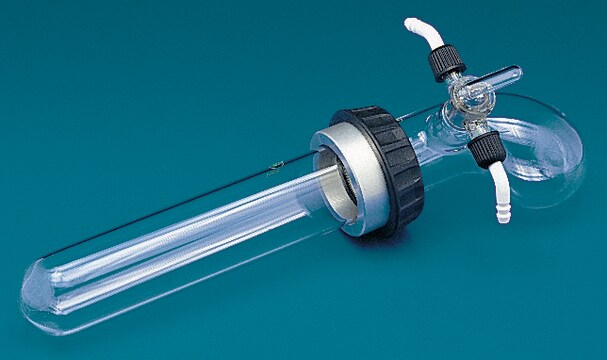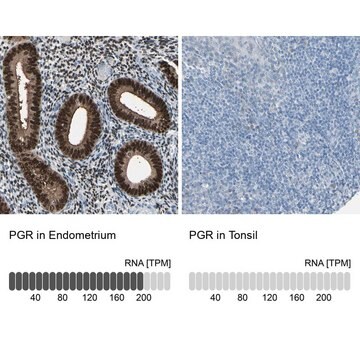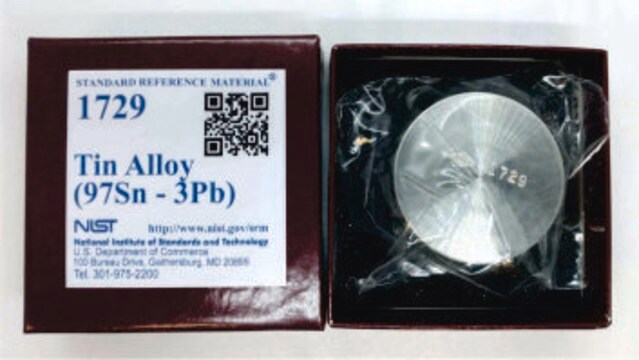Wszystkie zdjęcia(2)
Kluczowe dokumenty
GF91314468
Tin
rod, 500mm, diameter 2.0mm, 99.999+%
Synonim(y):
SN007915
Zaloguj sięWyświetlanie cen organizacyjnych i kontraktowych
About This Item
Wzór empiryczny (zapis Hilla):
Sn
Numer CAS:
Masa cząsteczkowa:
118.71
Numer MDL:
Kod UNSPSC:
12141745
Identyfikator substancji w PubChem:
NACRES:
NA.23
Polecane produkty
Próba
≥99.999%
Formularz
rod
producent / nazwa handlowa
Goodfellow 913-144-68
rezystywność
11 μΩ-cm, 20°C
bp
2270 °C (lit.)
mp
231.9 °C (lit.)
gęstość
7.310 g/mL at 25 °C (lit.)
ciąg SMILES
[Sn]
InChI
1S/Sn
Klucz InChI
ATJFFYVFTNAWJD-UHFFFAOYSA-N
Powiązane kategorie
Opis ogólny
Aktualne informacje dotyczące kart charakterystyki substancji niebezpiecznych można znaleźć na stronie www.goodfellow.com.
Informacje prawne
Product of Goodfellow
Ta strona może zawierać tekst przetłumaczony maszynowo.
Wybierz jedną z najnowszych wersji:
Certyfikaty analizy (CoA)
Lot/Batch Number
It looks like we've run into a problem, but you can still download Certificates of Analysis from our Dokumenty section.
Proszę o kontakt, jeśli potrzebna jest pomoc Obsługa Klienta
Masz już ten produkt?
Dokumenty związane z niedawno zakupionymi produktami zostały zamieszczone w Bibliotece dokumentów.
M R Krigman et al.
Neurotoxicology, 5(2), 129-139 (1984-01-01)
The toxicology of tin is almost entirely the toxicology of the organic compounds of tin, for the metal itself and its inorganic compounds appear to be nearly harmless for practical purposes. Furthermore, the neurotoxicity of organotin is essentially that of
Heinz Rüdel
Ecotoxicology and environmental safety, 56(1), 180-189 (2003-08-14)
This article reviews the literature related to the bioavailability of tin, inorganic tin compounds, and organotin compounds. On the one hand, the toxicity of metallic tin and inorganic tin compounds is low. In aqueous systems, the potential bioavailability of tin
Steve Blunden et al.
Food and chemical toxicology : an international journal published for the British Industrial Biological Research Association, 41(12), 1651-1662 (2003-10-18)
Tinplate is light gauge, steel sheet or strip, coated on both sides with commercially pure tin and has been used for well over a hundred years as a robust form of food packaging. Altogether, about 25,000 million food cans are
Commonly used methods of analysis for tin in foods.
W Horwitz
Journal - Association of Official Analytical Chemists, 62(6), 1251-1264 (1979-11-01)
P Mushak
Neurotoxicology, 5(2), 163-176 (1984-01-01)
Methods for both total and form-variable tin analysis in biological media are reviewed. While total tin analysis was common in the past, and in some cases still is, better understanding of the toxicology and toxicokinetics of organotins in biological systems
Global Trade Item Number
| SKU | GTIN |
|---|---|
| GF91314468-1EA | 4061825385068 |
| GF91314468-2EA | 4061829512545 |
Nasz zespół naukowców ma doświadczenie we wszystkich obszarach badań, w tym w naukach przyrodniczych, materiałoznawstwie, syntezie chemicznej, chromatografii, analityce i wielu innych dziedzinach.
Skontaktuj się z zespołem ds. pomocy technicznej





